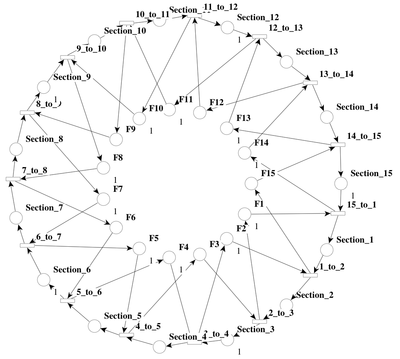Petriscript
PetriScript is a modelling language for Petri nets, designed by Alexandre Hamez and Xavier Renault.[1]
The CPN-AMI platform provides many tools to work on Petri nets, such as verifying or model-checking tools.[2] It was easily possible to graphically design simple Petri nets with Macao, but various works made internally at LIP6 reveal that it was needed to automate such task.[3]
Therefore, PetriScript has been designed to provide some facilities in modelling places-transition and coloured Petri nets within the CPN-AMI platform.
Its main purpose is to automate modelling operations on Petri nets such as merging, creating, and connecting nodes. Thus, it supports almost everything needed like macros, loops control, lists, string and arithmetic expressions, and avoids to the maximum the intervention of the user. Its syntax is more or less Ada-like.
For example, the following script produces a FIFO with three sections:
define(FIFO_SIZE,3)
define(FIFO_BASE_X,100)
define(FIFO_BASE_Y,100)
define(FIFO_STEP,120)
int $wave := 0;
for $wave in 1..FIFO_SIZE loop
create place "Slot_" & '$wave' (x FIFO_BASE_X + FIFO_STEP * $wave,
y FIFO_BASE_Y);
create place "Empty_" & '$wave' (x FIFO_BASE_X + FIFO_STEP * $wave,
y FIFO_BASE_Y + 100, marking "1");
end loop;
for $wave in 1..FIFO_SIZE+1 loop
create transition "t" & '$wave -1' & "_to_" & '$wave' (x FIFO_BASE_X + FIFO_STEP * $wave - FIFO_STEP / 2,
y FIFO_BASE_Y + 50);
if $wave < FIFO_SIZE+1 then
connect "1" transition "t" &'$wave -1' & "_to_" & '$wave' to place "Slot_" & '$wave';
connect "1" place "Empty_" & '$wave' to transition "t" &'$wave -1' & "_to_" & '$wave';
end if;
if $wave > 1 then
connect "1" transition "t" &'$wave -1' & "_to_" & '$wave' to place "Empty_" & '$wave - 1';
connect "1" place "Slot_" & '$wave - 1' to transition "t" &'$wave -1' & "_to_" & '$wave';
end if;
end loop;
set transition "t0_to_1" to (name "FIFO_Start");
set transition "t" & 'FIFO_SIZE' & "_to_" & 'FIFO_SIZE + 1' to (name "FIFO_End");
Which produces the following graph:

Here is another example that shows the power of PetriScript:
define(X,250) define(Y,350) define(radius,50) define(R,150) define(SECTIONS,15) define(INNER_ANGLE,360/SECTIONS) define(OUTER_ANGLE,360/(2*SECTIONS)) int $i := 0; int $j := 0; for $i in 1.. SECTIONS loop create place "F" & '$i' ( x X, y Y, r radius, t $i * INNER_ANGLE); create place "Section_" & '$i' ( x X, y Y, r R, t $i * INNER_ANGLE); create transition "t" & '$i' & "_to_" & '$i mod SECTIONS + 1' ( x X, y Y, r R, t $i * INNER_ANGLE + OUTER_ANGLE); end loop; for $i in 1.. SECTIONS loop connect place "Section_" & '$i' to transition "t"&'$i' & "_to_" & '$i mod SECTIONS + 1'; connect transition "t" & '$i' & "_to_" & '$i mod SECTIONS + 1' to place "Section_" & '$i mod SECTIONS + 1'; if $i /= 1 then connect place "F" & '$i' to transition "t" & '$i-1' & "_to_" & '$i'; else connect place "F1" to transition "t" & 'SECTIONS' & "_to_" & '1'; end if; connect transition "t" &'$i mod SECTIONS + 1' & "_to_" & '($i+1) mod SECTIONS + 1' to place "F" & '$i'; end loop; for $i in 1.. SECTIONS loop if $i mod 3 = 0 then set place "Section_" & '$i' to marking "1"; else set place "F" & '$i' to marking "1"; end if; end loop;
Which produces the following graph:

References
- ↑ https://www.lip6.fr/cpn-ami-doc/PetriScript_Reference_Manual.pdf
- ↑ Principles of Information Systems: Computer science
- ↑ Business Database Systems: Computer science, Database management
External links
Full documentation is available here.